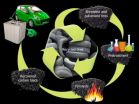(Press-News.org) Attaching a stone tip on to a wooden spear shaft was a significant innovation for early modern humans living around 500,000 years ago. However, it was also a costly behavior in terms of time and effort to collect, prepare and assemble the spear. Stone tips break more frequently than wooden spears, requiring more frequent replacement and upkeep, and the fragility of a broken point could necessitate multiple thrusts to an angry animal. So, why did early hunters begin to use stone-tipped spears?
To learn if there was a "wounding" advantage between using a wooden spear or a stone-tipped spear, ASU postdoctoral researcher Jayne Wilkins, doctoral student Benjamin Schoville and coauthor Kyle Brown from the University of Cape Town, conducted controlled experiments using tipped and untipped spear replications, a calibrated crossbow and ballistics gelatin. The experiments looked at the size and shape of the "wound," penetration depth and damage done by extraction of the spear. Wilkins and Schoville are affiliated with the Institute of Human Origins, a research center of the ASU College of Liberal Arts and Sciences in the School of Human Evolution and Social Change.
Their experiments found that although tipped spears did not penetrate deeper than the untipped spears as is commonly thought, the tipped spears create wider wound cavities. These wider wound cavities would have caused more debilitating tissue damage to internal organs of animals, making hunts more successful. This is one explanation for an evolutionary advantage for tipped a spear with a stone, an innovation that may have significantly impacted the evolution of human life-history.
"Putting a fragile stone tip on a spear is risky," said Schoville, "but we show that there are serious rewards in terms of both the size and shape of the wound created that made this innovation extremely worthwhile during our evolution."
The authors also posit that the manufacture of the stone-tipped spears may represent the origin of new cognitive and social development in our human ancestors. Working memory (the ability to hold attention to multiple tasks in order to collect, prepare and combine different kinds of raw materials into a weapon), and constructive memory (the ability to imagine and plan for future tasks), were mental capacities required for tipped spear construction. In addition, since a stone-tipped spear is a skill likely to have been learned by being passed from generation to generation through social or group learning, stone-tipped technology is evidence of the evolutionary impact of "cumulative culture."
The flip side of this greater human cooperation is where groups and individuals are more likely to cooperate when others have very lethal weapons—a situation still in play today.
INFORMATION:
The study "An Experimental Investigation of the Functional Hypothesis and Evolutionary Advantage of Stone-Tipped Spears" will be published August 27, 2014 in the open-access journal PLOS ONE at http://dx.plos.org/10.1371/journal.pone.0104514.
Source
Benjamin Schoville
(Cape Town, South Africa) +27 076 136 4669
Benjamin.Schoville@asu.edu
Media contact
Julie Russ
480-727-6571
jruss@asu.edu
Stone-tipped spears lethal, may indicate early cognitive and social skills
The manufacture of stone-tipped spears is a skill likely to have been learned by being passed from generation to generation through social or group learning
2014-08-27
ELSE PRESS RELEASES FROM THIS DATE:
Orphaned children can do just as well in institutions
2014-08-27
DURHAM, N.C. -- The removal of institutions or group homes will not lead to better child well-being and could even worsen outcomes for some orphaned and separated children, according to new findings from a three-year study across five low- and middle-income countries.
Children in institutions are as healthy and, in some ways, healthier than those in family-based care, according to the study, which was led by Kathryn Whetten, a Duke professor of public policy and director of the Center for Health Policy and Inequalities Research (CHPIR).
In the largest and most geographically ...
Self-deceived individuals deceive others better
2014-08-27
Over confident people can fool others into believing they are more talented than they actually are, a study has found.
These 'self-deceived' individuals could be more likely to get promotions and reach influential positions in banks and other organisations. And these people are more likely to overestimate other people's abilities and take greater risks, possibly creating problems for their organisations.
The study by researchers from Newcastle University and the University of Exeter, has also found that those who are under confident in their own abilities are viewed ...
Brain networks 'hyper-connected' in young adults who had depression
2014-08-27
Depression may be better predicted and understood now that University of Illinois at Chicago researchers have discovered that young adults who previously experienced the mental illness have hyper-connected emotional and cognitive networks in the brain.
UIC researchers used functional magnetic resonance imaging to examine the brain connectivity of young adults ages 18 to 23 while they were in a resting state. Thirty unmedicated young adults who had previously experienced depression and 23 healthy controls were used in the study, which has been published online in the journal ...
Malaria symptoms fade on repeat infections due to loss of immune cells, UCSF-led team says
2014-08-27
Children who repeatedly become infected with malaria often experience no clinical symptoms with these subsequent infections, and a team led by UC San Francisco researchers has discovered that this might be due at least in part to a depletion of specific types of immune cells.
Working in Uganda, one of the most malaria-plagued nations in Africa and one in which individuals are repeatedly exposed to the malaria parasite, UCSF scientists found that a depletion of immune cells known as gamma delta T cells diminishes inflammatory responses in infected children — responses ...
Tracking spending among the commercially insured
2014-08-27
LEBANON, NH – Recent growth in health care spending for commercially insured individuals is due primarily to increases in prices for medical services, rather than increased use, according to a new study led by researchers at The Dartmouth Institute for Health Policy & Clinical Practice, published in the August issue of the American Journal of Managed Care.
There is increasing concern that consolidation in the health care marketplace will lead to increased prices faced by payers and, ultimately, consumers," said Carrie Colla, PhD, assistant professor at The Dartmouth ...
Encyclopedia of how genomes function gets much bigger
2014-08-27
A big step in understanding the mysteries of the human genome was unveiled today in the form of three analyses that provide the most detailed comparison yet of how the genomes of the fruit fly, roundworm, and human function.
The research, appearing August 28 in in the journal Nature, compares how the information encoded in the three species' genomes is "read out," and how their DNA and proteins are organized into chromosomes.
The results add billions of entries to a publicly available archive of functional genomic data. Scientists can use this resource to discover ...
Rubber meets the road with new ORNL carbon, battery technologies
2014-08-27
OAK RIDGE, Tenn., Aug. 27, 2014 – Recycled tires could see new life in lithium-ion batteries that provide power to plug-in electric vehicles and store energy produced by wind and solar, say researchers at the Department of Energy's Oak Ridge National Laboratory.
By modifying the microstructural characteristics of carbon black, a substance recovered from discarded tires, a team led by Parans Paranthaman and Amit Naskar is developing a better anode for lithium-ion batteries. An anode is a negatively charged electrode used as a host for storing lithium during charging.
The ...
Gang life brings deep health risks for girls
2014-08-27
Being involved in a gang poses considerable health-related risks for adolescent African American girls, including more casual sex partners and substance abuse combined with less testing for HIV and less knowledge about preventing sexually transmitted diseases, according to a new study.
The findings come from a questionnaire survey with 188 African American females, ages 13 to 17, who were incarcerated in a short-term detention facility in Atlanta. The data showed that low self-esteem, emotional problems, trauma history, low parental monitoring, friends who engage in risky ...
Kessler Foundation researchers publish first study of brain activation in MS using fNIRS
2014-08-27
West Orange, NJ. August 27, 2014. Using functional near infrared spectroscopy (fNIRS), Kessler Foundation researchers have shown differential brain activation patterns between people with multiple sclerosis (MS) and healthy controls. This is the first MS study in which brain activation was studied using fNIRS while participants performed a cognitive task. The article, "Neuroimaging and cognition using functional near infrared spectroscopy (fNIRS) in multiple sclerosis," was published online on June 11 by Brain Imaging and Behavior. Authors are Jelena Stojanovic-Radic, PhD, ...
Water 'thermostat' could help engineer drought-resistant crops
2014-08-27
DURHAM, N.C. -- Duke University researchers have identified a gene that could help scientists engineer drought-resistant crops. The gene, called OSCA1, encodes a protein in the cell membrane of plants that senses changes in water availability and adjusts the plant's water conservation machinery accordingly.
"It's similar to a thermostat," said Zhen-Ming Pei, an associate professor of biology at Duke.
The findings, which appear Aug. 28 in the journal Nature, could make it easier to feed the world's growing population in the face of climate change.
Drought is the ...
LAST 30 PRESS RELEASES:
Injectable breast ‘implant’ offers alternative to traditional surgeries
Neuroscientists devise formulas to measure multilingualism
New prostate cancer trial seeks to reduce toxicity without sacrificing efficacy
Geometry shapes life
A CRISPR screen reveals many previously unrecognized genes required for brain development and a new neurodevelopmental disorder
Hot flush treatment has anti-breast cancer activity, study finds
Securing AI systems against growing cybersecurity threats
Longest observation of an active solar region
Why nail-biting, procrastination and other self-sabotaging behaviors are rooted in survival instincts
Regional variations in mechanical properties of porcine leptomeninges
Artificial empathy in therapy and healthcare: advancements in interpersonal interaction technologies
Why some brains switch gears more efficiently than others
UVA’s Jundong Li wins ICDM’S 2025 Tao Li Award for data mining, machine learning
UVA’s low-power, high-performance computer power player Mircea Stan earns National Academy of Inventors fellowship
Not playing by the rules: USU researcher explores filamentous algae dynamics in rivers
Do our body clocks influence our risk of dementia?
Anthropologists offer new evidence of bipedalism in long-debated fossil discovery
Safer receipt paper from wood
Dosage-sensitive genes suggest no whole-genome duplications in ancestral angiosperm
First ancient human herpesvirus genomes document their deep history with humans
Why Some Bacteria Survive Antibiotics and How to Stop Them - New study reveals that bacteria can survive antibiotic treatment through two fundamentally different “shutdown modes”
UCLA study links scar healing to dangerous placenta condition
CHANGE-seq-BE finds off-target changes in the genome from base editors
The Journal of Nuclear Medicine Ahead-of-Print Tip Sheet: January 2, 2026
Delayed or absent first dose of measles, mumps, and rubella vaccination
Trends in US preterm birth rates by household income and race and ethnicity
Study identifies potential biomarker linked to progression and brain inflammation in multiple sclerosis
Many mothers in Norway do not show up for postnatal check-ups
Researchers want to find out why quick clay is so unstable
Superradiant spins show teamwork at the quantum scale
[Press-News.org] Stone-tipped spears lethal, may indicate early cognitive and social skillsThe manufacture of stone-tipped spears is a skill likely to have been learned by being passed from generation to generation through social or group learning





